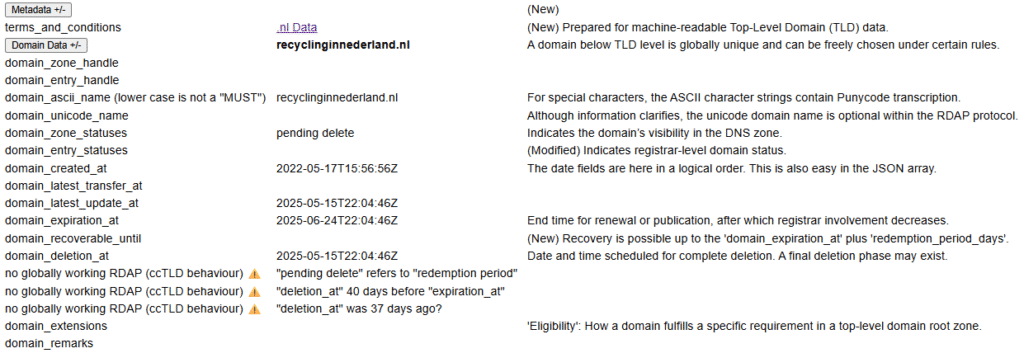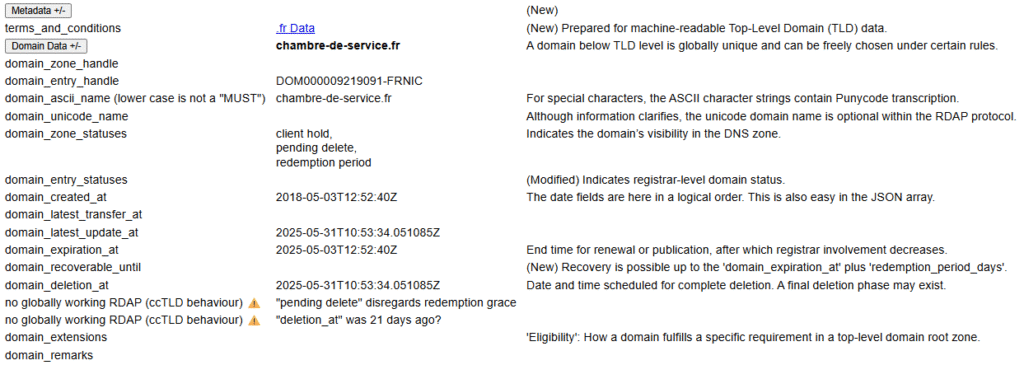About The Work here
This page shares an exploratory approach to understanding and modeling complex digital domains—especially in RDAP, identity, and strategic IT roles. While not based on scientific publications, it draws on practical experience and systems thinking to highlight real organizational challenges and opportunities.
For policymakers: This insight supports informed decision-making by clarifying how technical, organizational, and legal factors interact within digital infrastructure, providing a foundation for strategic planning and accountability across government IT domains.
→ Understanding people and roles
“Specialists respond best when issues are explained in context — not just technically, but as real situations.”
“Managers add value beyond the technical peak, especially as IT challenges increasingly outpace traditional education.”
→ Moving beyond isolated IT
“Effective resolution of complex issues must extend beyond the support sandbox—it requires full organizational accountability.”
“IT requires a strategic starting point overseeing a collaborative domain, then technical implementation, and legal finalization.”
“A strategic IT team can operate above ministerial boundaries, freeing those roles to focus on tactical resource efficiency.”
→ Standards and global positioning
“IT standards are best understood through clear, targeted training materials.”
“A Dutch expert group could play a pivotal role in aligning global IT developments.”
→ Identity and digital infrastructure
“WebIDs are still evolving—common names like ‘Peter Jansen’ cannot be relied on as unique identifiers.”
→ Strategic guidance and domain awareness
“An effective Digital Affairs Team should provide guidance with the strategic insight of seasoned government finance experts.”
“While the complexity is real, treating domains like healthcare and housing as distinct areas of focus can better support progress in IT.”
Regarding Web Domain and Hosting Control:
The Dutch website en.internet.nl/ provides essential to-do points for responsible parties, based on the outcome of automated tests.
It is worth noting the following points.
- Due to the broad range of test topics, a critical issue may result in only a minor deduction from an otherwise near-perfect score;
- A closed server can still achieve a score of 61% for web and 70% for email, based solely on DNS configuration—despite being inaccessible;
- Domain naming challenges often require country-specific solutions. While the necessary technical tools nearly exist, political awareness is key.
This issue could be effectively addressed under the remit of the Ministry of General Affairs, as technical experts alone are unlikely to resolve it; - The current “Hall of Fame” model may need to evolve toward more future-proof methods, including testing with email-based user identification;
- As in my tools, I recommend adopting a four-column format that presents IPv4 and IPv6 results separately, rather than combining them;
- Email functionality—both sending and receiving—depends on many factors. Unfortunately, a score of 100% misleads.
From Actionable Screenshots to Resolution and Management-Readable Post-Mortem Reviews
- Free Domain Lookup, including DNSSEC and Whois (PHP/Python/JSON, since August 15, 2021) — rdap.hostingtool.nl/modeling_domain/
- Free Server Header Lookup, to phase out (PHP/XML, since January 14, 2022) — www.hostingtool.nl/server_headers/
- Free Domain Control Register ® (PHP/JSON, since November 30, 2024) — www.domaincontrolregister.org/
- Free Homepage Route Overview (PHP/Python, since February 26, 2025) — www.workingornot.org/
- Free Security Header Overview (PHP/Python, since March 18, 2025) — securityheaders.hostingtool.org/
- Free Hosting Lookup (PHP/Python/JSON, since May 6, 2025) — lookup.hostingtool.org/
- Free Top-level Domain Lookup (PHP/JSON, since June 21, 2025) — rdap.hostingtool.nl/modeling_tld/
Fragmented ccTLD Systems: The Modeling Barrier ICANN Must Address
- ICANN’s limited visibility into the diverse software environments powering ccTLD operations is causing systemic fragmentation — a significant obstacle to achieving unified, country-proof registry modeling;
- PostgreSQL’s JSON and JSONB field types offer robust support for semi-structured identifier string properties specific to TLDs, enabling seamless integration of data from multiple databases. However, the current RDAP vCard array output for addresses lacks the structured format necessary for reliable data entry and clear human readability. For example, the inconsistent mixing of country codes and country names in RDAP responses creates confusion and processing difficulties;
- In practice, the Netherlands use indexed table fields for postal code searches to enhance performance. Yet, the practice of nesting entities within other entities introduces unnecessary complexity, hindering both machine processing and user-friendly display. Furthermore RDAP’s physical data structure should ensure role-specific visibility;
- Currently, many ccTLD registries rely heavily on registrar input for data management. Without additional authoritative oversight, this reliance can impact data completeness and accuracy. This highlights the urgent need for automated, standardized processes to improve data integrity across the global registry ecosystem;
- If a domain name is marked with the “
pending delete” status, it MUST NOT be marked with “redemption period” concurrently, and vice versa.
Up-to-Date PostgreSQL Registry Table Definition (Since May 31, 2025)
Developed to replace legacy registry systems and support deployment on global RDAP servers, this schema upgrade enhances data clarity, consistency, and maintainability, representing a critical step forward in modernizing the RDAP protocol.
Machine-Readable IANA Root Zone Data:
My IANA root zone data is in a renewed format, to be retrieved from a designated IANA server and relying on user activity logging—including from unidentified internet users—for issue resolution, the tool avoids unnecessary traffic, reduces system overhead, and supports traceable, efficient operations.
Concerning Allowed Legacy Behavior in the .nl Domain (Netherlands)

– External SIDN whistleblowing and also contacting the Netherlands Standardisation Forum;
– SIDN could fulfill the gTLD operational requirements for .amsterdam and .politie if adequately maintained;
– The .frl root zone for the province of Friesland is maintained in England and has been updated;
– Find a final stage ccTLD domain: https://www.catchtiger.com/nl/domeinnaam-veilingen/
or for gTLD: https://www.expireddomains.net/expired-domains/
- .nl root zone – Clearer Whois (15 open and 3 realized suggestions)
- Steps for Domain Registration (35 suggestions)
- NL country – List Whois (5 suggestions)
Concerning Allowed Legacy Behavior in the .fr Domain (France)

Concerning Allowed Legacy Behavior in the .de Domain (Germany)

Recommended Actions for Strengthening Digital Governance in the Netherlands
1. Establish a Governing Board
Create an independent oversight body composed of experts responsible for supervising national digital activities, policies, and strategic direction—including oversight of the .nl domain and broader digital infrastructure management. These areas involve highly complex technical challenges that require specialized expertise beyond the capabilities of most stakeholders. The board would ensure transparency, resilience, and alignment with the public interest.
2. Avoid Appointing a Minister of Digital Affairs
While appointing a dedicated minister may seem like a logical step toward centralization, it risks politicizing a domain that should remain technically focused and multi-stakeholder driven. Effective oversight requires continuity, expertise, and agility—traits often constrained within conventional ministerial structures.
3. Leverage Existing Expertise through a Think Tank
Establish a dedicated think tank—Team Digitale Zaken—to consolidate digital governance expertise, advise government ministries, and ensure a cohesive, forward-looking national digital policy. This team would develop operational routines and institutional memory to respond effectively to digital disturbances or incidents. Embedded expertise would enhance the government’s capacity to manage crises with agility and technical precision. Continuous learning is essential to maintaining the team’s effectiveness.
4. Designate Team Digitale Zaken as ccTLD Manager (Long-Term Vision)
Position Team Digitale Zaken to be considered as a designated manager candidate for the .nl country code top-level domain (ccTLD). This transition would require close cooperation with ICANN, recognizing that any change in management must follow its formal global approval process.
About Dutch ccTLD and geoTLD Control:
- While the Ministry of Economic Affairs provides a legal framework until November 21, 2029, this control remains primarily a policy objective. In practice, operational responsibility for the
.nldomain lies with SIDN and is expected to remain there for the foreseeable future. - The update to reflect SIDN B.V. as the Backend Operator—effective January 1, 2023—remains pending in the IANA database. Although still necessary, this is regarded as a technical matter and constitutes a procedural update within the IANA framework, not requiring the development of new ICANN policy.
- The
.frltop-level domain is a sponsored TLD privately managed by FRLregistry B.V.
Ministry of General Affairs:
- Govern IT under a Cabinet Office. And dismiss unnecessary advisory bodies.
– UK’s Cabinet Office falls under the Ministry of General Affairs. If realized in NL: “Kabinetsbureau”.
– UK’s Government Digital Service (GDS) operates hierarchically under the Cabinet Office; - Generate training material for further education from the European Cloud, which is in preparation.
– The AWS GovCloud in the United States, is managed by Amazon.
– Organizations using GovCloud must verify that all individuals with access to the environment are U.S. citizens.
– GovCloud cannot be used by foreign nationals or organizations, even if they have legitimate access to other AWS services; - Work on a Dutch or EU Digital Service for generic application software related to DNS and registries.
– Well-considered proposals, RFC and non-RFC, could feed the IANA organization.
Ministry of Economic Affairs:
- Include automated task costs in just one annual web domain fee;
- Include a change in a registrar’s own data in its period costs;
- Eliminate all registry discounts. A volume discount causes unfair competition.
Ministry of the Interior and Ministry of Justice:
- List areas of expertise, engage specialists, ensure dynamic interaction and make decisions;
- Make the country of the real domain user leading for country-specific Web Domain Services (WDSs).
– For the NL, the “Stichting Inlichtingenbureau” in Utrecht could assist for a new “Webdomeindienst”;
– WDS register data officers are confirmed by his/her director in that country; - Maintain IT knowledge with a long-standing EU group of stakeholders;
NL / EU / US and including generic top-level domain zones:
- Discuss global design and programming of Registration Data Access Protocol software.
– Introduce in RDAP an emergency entity in order to formally organize backup to get access.
– Introduce in RDAP a fallback entity in order to respond when registrant information is missing; - Generate web IDs that start with the ISO2 country code, for business entities and natural persons;
- Plan verification of web domain users indexed by web ID, starting with modeling in RDAP like mine;
- Use the developed Domain Control Register ®, based on the real web domain user.
– Report regarding expired HTTPS, security.txt or DANE via email. Perhaps a DCR revenue model; - Get custom fields approved and listed for standardization in the dynamic RDAP protocol.
– A simple data structure has been designed for the registry details;
Our Sites
- facilitating/hosting events: hostfusion.nl/
- technical documentation: webhostingtech.nl/
